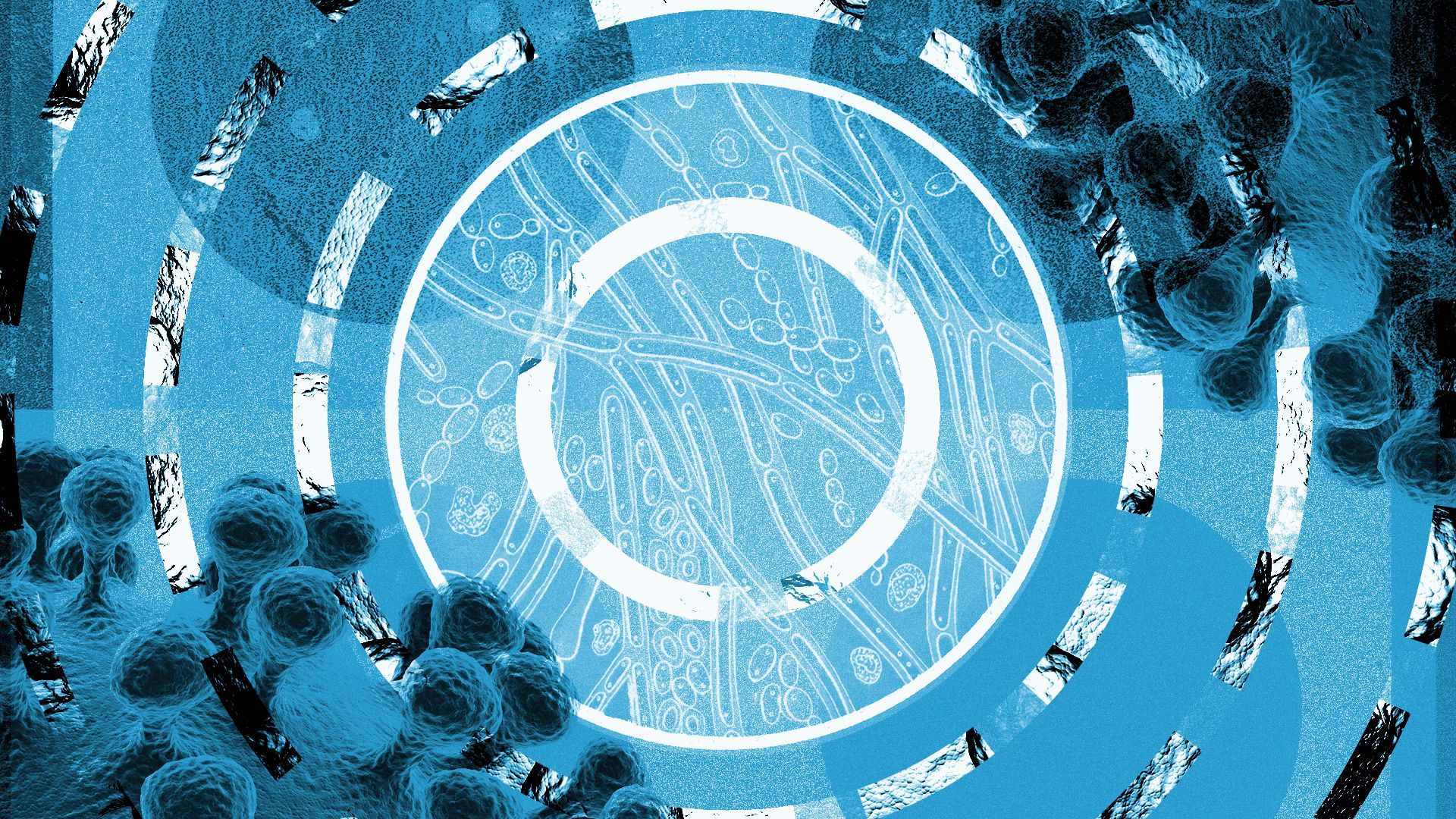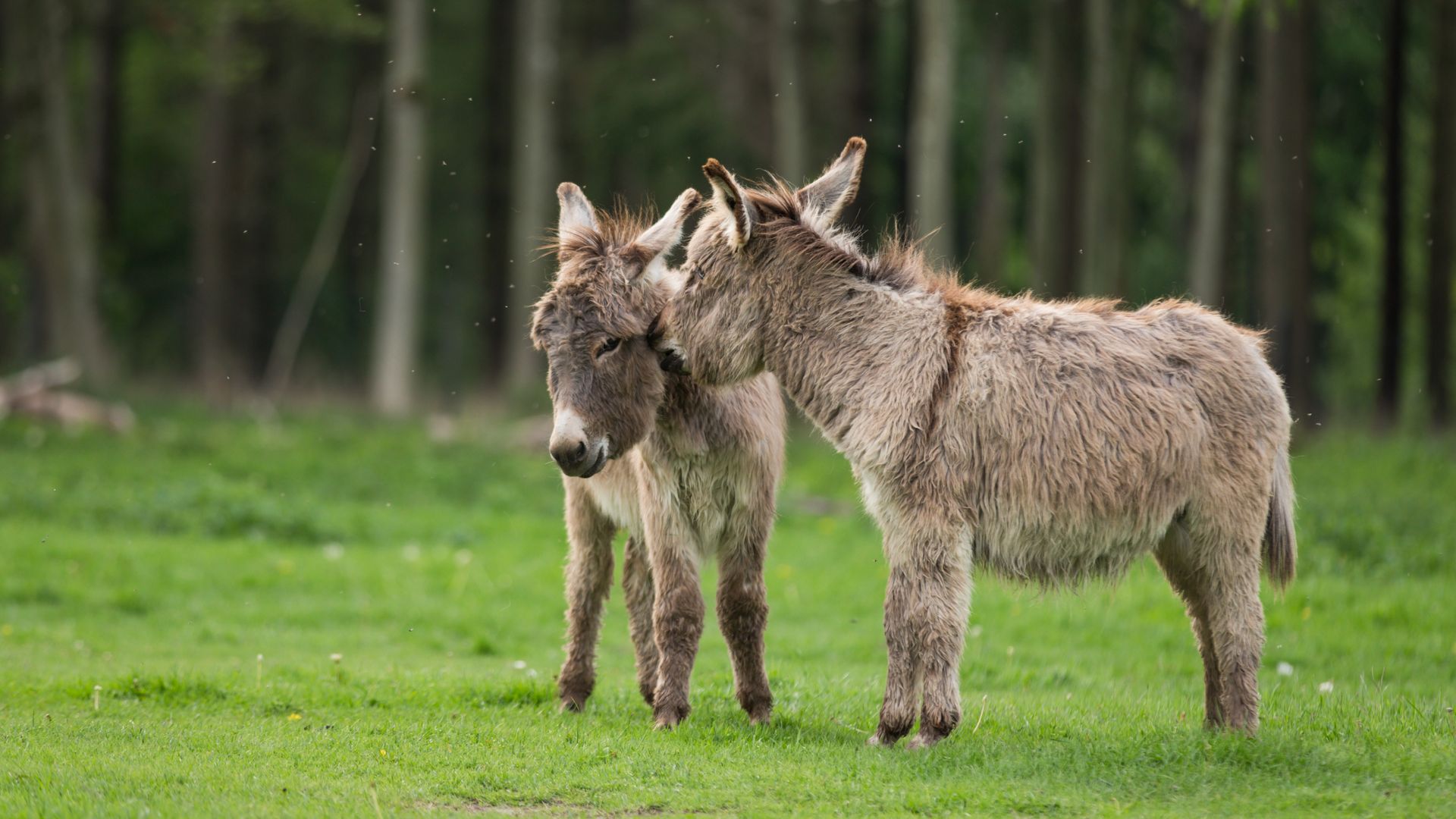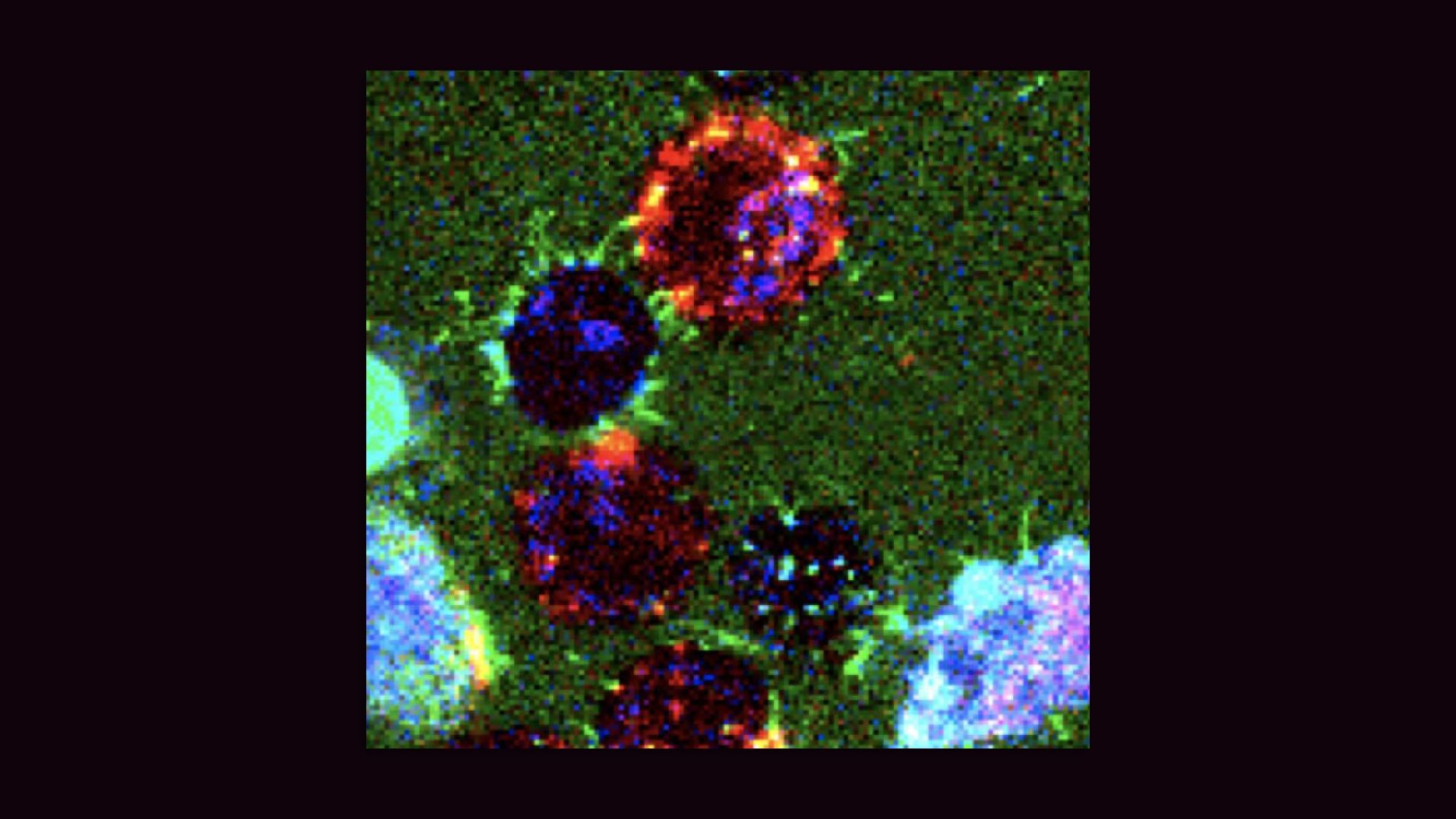| | | | | | | | | | | Axios Science | | By Alison Snyder · Sep 08, 2022 | | Thanks for reading Axios Science. This week's edition — about renewed focus on fighting superbugs, the domestication of one of the most important animals for humans and nano-scale plumbing — is 1,687 words, about a 6-minute read. Send your feedback and ideas to me at alison@axios.com. You can reach Eileen Drage O'Reilly at eileen@axios.com. - This newsletter will be off next week and back to your inbox on Sept. 22.
- Sign up here to receive this newsletter.
| | | | | | 1 big thing: Superbugs are a "second punch" after pandemic |  | | | Illustration: Shoshana Gordon/Axios | | | | Superbugs are strengthening their foothold: The COVID-19 pandemic spurred a 15% increase in hospital-related infections and deaths in 2020, per the CDC, Axios' Eileen Drage O'Reilly writes. Why it matters: The U.S. was already reporting an antimicrobial resistant (AMR) infection every 11 seconds, and a death from them every 15 minutes before the pandemic. Low- and middle-income countries face worse conditions. State of play: The COVID pandemic erased years of progress achieved in fighting AMR, the CDC's Michael Craig told the annual World Antimicrobial Resistance Congress this week. He warned the threat of pandemics is not going away, and "the pandemic of [antimicrobial] resistance is not going to go away." - The increase in drug-resistant infections seen in 2020 may be partly due to the overprescription of antibiotics to COVID patients and increased use of catheters and ventilators that can lead to infections. Some of the hardest-to-treat infections jumped nearly 80%.
- It's important to address AMR, HHS Secretary Xavier Becerra said, because "for many of us it's not so much the first punch. It's the second punch that gets the communities in America. ... The second punch gets those who are least prepared, the most vulnerable, and the most underserved."
By the numbers: Per the CDC, hospitalizations from 2019 to 2020 showed a ... - 78% jump in carbapenem-resistant Acinetobacter infections.
- 32% rise in multidrug-resistant Pseudomonas aeruginosa infections.
- 14% increase in vancomycin-resistant Enterococcus infections.
- 13% rise in methicillin-resistant Staphylococcus aureus, or MRSA infections.
- Overall increase in antifungal-resistant infections, including Candida auris, which increased 60%.
- Resistant sexually transmitted diseases, like gonorrhea, are a growing threat, per the WHO, which aims to increase reporting of cases to its surveillance program.
Between the lines: There's an urgent need for novel antibiotics, antifungals and preventative vaccines, fast and inexpensive diagnostics, a coordinated surveillance system, a renewed focus on antibiotic stewardship programs and better public awareness communications. - Craig points out that developing more vaccines will help prevent infections and deaths as well as lower the risk of AMR because fewer antibiotics will be used overall.
- Kevin Outterson, co-director of Boston University's health law program and executive director of CARB-X, told Axios "research teams are weighed down by the failure of how we pay for antibiotics."
- There's been "no new FDA antibiotic approvals since cefiderocol. The out-of-pocket cost of bringing a new compound to FDA approval exceeds $300 million," not counting the cost of failures along the way or the cost of capital to companies investing in this research, Outterson said. Many companies have declared bankruptcy.
- WHO's Hatim Sati told the conference "fungal pathogens are increasingly becoming a concern" but only 1.5% of all infectious disease research is looking at antifungals and there are only eight candidates in the pipeline.
What we're watching: Calls are growing for Congress to approve the PASTEUR Act to create incentives to develop new antimicrobial drugs, although some say a broader conversation is needed to see if vaccines and antibiotics need to be incentivized differently. - The WHO will release its first Fungal Priority Pathogen list on Oct. 4 that it hopes will encourage R&D, Sati said.
|     | | | | | | 2. When donkeys were domesticated |  | | | Donkeys at Copenhagen Zoo. Photo: Frank Rønsholt | | | | Genetic analysis indicates donkeys were domesticated about 7,000 years ago in East Africa, according to a new study. The big picture: Throughout history, donkeys have supported humans in agriculture, wars, and other events and activities that shaped civilizations. They continue to play an important role in communities around the world. But it was unknown when they were first domesticated. - "Understanding their genetic makeup is not only key to assessing their contribution to human history but also to improving their local management in the future," the authors of the new study write in the journal Science.
Details: Researchers analyzed DNA collected from more than 200 donkeys (Equus asinus) in 31 countries around the world and from 31 ancient donkeys and 15 wild asses. - They found donkeys were domesticated around 5,000 years BC in a single domestication event in Africa. That happened 3,000 years before horses were domesticated, which happened twice.
- Donkeys then expanded throughout Africa and to Europe and Asia, where genetically distinct groups eventually emerged.
The intrigue: It's unclear why people decided to domesticate wild donkeys in Africa 7,000 years ago but it happened when the Sahara became more arid, per Freda Kreier of Science News. - It could have been that donkeys assisted with moving goods across an increasingly dry desert.
What's next: The researchers suggest further study of donkey diversity around the world could "uncover the genetic basis of desert adaptations, which could prove invaluable for future donkey breeding in the face of global warming." |     | | | | | | 3. What the Moon can tell us about Earth |  | | | Illustration: Annelise Capossela/Axios | | | | The Moon is a time capsule that could provide key information about Earth's ancient history, Axios' Miriam Kramer writes. Why it matters: Understanding the early history of our planet and our Moon could help scientists figure out more about how the planets formed and even how life eventually took hold on our world. - "When you look at the Moon, you're looking at not just a neighbor in space, but kind of an extension of the Earth," NASA Moon scientist Noah Petro tells Axios.
- "I like to kind of glibly think of the Moon as the eighth continent of the Earth."
The big picture: As NASA aims to send astronauts back to the Moon for the first time since Apollo as part of its Artemis program, scientific attention is now turning to the Moon, with researchers hopeful that some of their outstanding questions will be answered. - Instead of visiting just a few landing sites once like the Apollo missions, Artemis aims to create a sustainable presence on the Moon.
- That would allow researchers to gain a deep understanding of that part of the lunar surface and potentially stage missions to other areas.
- "Part of the area where the Artemis missions will be exploring is on the rim of this enormous basin," Petro added. "We don't know how old it is. So for me, understanding the age of that crater becomes a very important point in the history of the Earth and the Moon's history in its formation."
How it works: The movement of Earth's tectonic plates constantly churns away craters and older crust, effectively hiding geological evidence of our planet's ancient past. - But the Moon — widely believed to have formed after a collision between Earth and a rocky body called Theia — is a record of that history.
- Because the Earth and the Moon occupy the same part of space, the craters — formed from collisions — seen on the Moon are likely representative of the same kinds of activity that happened on our planet as well
- Studying those craters could allow researchers to piece together just what was happening in space millions — if not billions — of years ago, possibly giving them clues about how life arose, how water was delivered to our planet, and how the Earth's crust, mantle and core evolved.
- Earth's "early record is lost, and we think it may have been really critical to when life was able to form on Earth," planetary geologist Brett Denevi, of Johns Hopkins University Applied Physics Laboratory, tells Axios. "It shapes that habitable environment and really affects it."
|     | | | | | | A message from Axios | | NEW: Subscribe to Axios Codebook | | |  | | | | Decode key cybersecurity news and insights. Dive into breaking news and long-term trends in the field, from ransomware and phishing to privacy and data protection to national security and disinformation. Subscribe for free | | | | | | 4. Worthy of your time | | The hunt for big hail (Oliver Whang — NYT) In the mind of a whale (Tom Mustill — Hakai) How a hidden cave can help scientists understand the climate (Emily Benson — High Country News) The world's oldest amputation may have happened in the Stone Age (Herb Scribner — Axios) |     | | | | | | 5. Something wondrous |  | | | Leak-free piping, visible as light green lines made with self-assembling DNA nanotubes. Credit: Johns Hopkins University | | | | Tiny tubes of DNA with diameters 2 million times smaller than the size of an ant can be used to move molecules through microscopic plumbing, according to a new study. Why it matters: Nano-plumbing could help researchers to study the intricacies of the body — for example, the chemical signals sent from individual neurons — or to analyze very small volumes of samples removed during surgery, said Rebecca Schulman, a professor of chemical and biomolecular engineering at Johns Hopkins University and a co-author of the new study. Background: Synthetic DNA can be used to make tiny holes or nanopores that can be used to move molecules across cell membranes or metal sheets — a technique used for DNA sequencing. Nanotubes are extensions of nanopores that function like pipes and can be hundreds of nanometers long. - But the tube width tends to be less than 2 nm, limiting the size of the molecules they can move.
- And the pipes can leak.
What's new: Scientists from Johns Hopkins University and the University of Illinois Urbana-Champaign were able to build a tube almost as long as a dust particle — large on the scale of a cell — from a pore and move molecules from one location to another one micron away. Details: Yi Li, who conducted the research as a graduate student at JHU, and his colleagues created the nano-pipes from short synthetic strands of DNA that self-assemble into hollow tubes. - The tubes were connected to a vesicle made in the lab, and one end was placed in a solution with fluorescent molecules that were then transported in the tubes.
- When the ends of the tubes were capped with DNA, the fluorescent molecules moved from one end of the tube to the other, demonstrating the tubes weren't leaky, the researchers reported in the journal Science Advances. The cap can also be used to control the flow of the solution.
- They also report the DNA tubes can self-repair.
These were "elegant experiments" and a "significantly new contribution" to the field, said Stefan Howorka, a professor of chemical biology at University College London who studies nanomaterials but wasn't involved in the new research. What's next: The researchers would have to test whether the nanotubes can move other molecules, both larger and smaller than the aspirin-sized one used in the study, Schulman said. - The stability of the nanotubes would also have to be tested in biological environments in order to use them to deliver drugs to the body.
- Another next step could be to try to use the tubes to connect two different vesicles, which could help to study how cells communicate, and to insert specific molecules into cells to better understand how cells respond to diseases, Howorka said.
|     | | | | | | A message from Axios | | NEW: Subscribe to Axios Codebook | | |  | | | | Decode key cybersecurity news and insights. Dive into breaking news and long-term trends in the field, from ransomware and phishing to privacy and data protection to national security and disinformation. Subscribe for free | | | | Thanks to Eileen for contributing this week, to Shoshana Gordon on the Axios Visuals team and to Carolyn DiPaolo for copy editing this edition. |  | | Are you a fan of this email format? It's called Smart Brevity®. Over 300 orgs use it — in a tool called Axios HQ — to drive productivity with clearer workplace communications. | | | | | | Axios thanks our partners for supporting our newsletters. If you're interested in advertising, learn more here.
Sponsorship has no influence on editorial content. Axios, 3100 Clarendon Blvd, Arlington VA 22201 | | | You received this email because you signed up for newsletters from Axios.
Change your preferences or unsubscribe here. | | | Was this email forwarded to you?
Sign up now to get Axios in your inbox. | | | | Follow Axios on social media:    | | | | | |








No comments:
Post a Comment